Going on two decades, Wi-Fi has delivered simple, inexpensive wireless connectivity for the masses. It was never perfect, but the convenience and generally fine performance for most applications made it good enough for most.
Now, the stakes are higher.
Consumers are requiring more demanding use cases and more powerful apps. Despite its promises, 5G connectivity remains limited. This has meant everyone from personal to enterprise users have been leaning heavier than ever on Wi-Fi to meet connectivity needs.
This has been a driving force behind a whole new generation of Wi-Fi tech and adoption. Whether working or playing from home, we expect Wi-Fi to operate flawlessly with high performance and reliability. This is especially true as Wi-Fi cements a role in mission-critical private networks that support emerging industry applications.
Wi-Fi is being positioned to meet these new roles and requirements. New Wi-Fi standards provide distributed connectivity, high throughput, and low latency. In particular, the radio interface has received an overhaul, with modulation and spectral efficiency on a completely new level.
Wi-Fi routers, extenders, and mesh networks are being installed in homes and offices to provide wider coverage, support more users, and accommodate a growing range of devices. Each brings pros and cons, but whichever is chosen, it is safe to say Wi-Fi networks have evolved far beyond initial roles as simple routers.
In fact, the changes seen in Wi-Fi introduce challenges that are in some ways more significant than the migration from 4G to 5G.
New Wi-Fi complexity means device testing has grown in complexity, too
As expectations of Wi-Fi surge, so too does the need for precise, comprehensive Wi-Fi network testing. As always, testing must address conformance to standards, interoperability, and performance. With Wi-Fi, many factors can impact performance, such as walls, electrical interference, , signal reflection, and other Wi-Fi and wireless usage in the area. All Wi-Fi devices must be tested against these factors in controlled, repeatable ways.
Wi-Fi sees multiple standards in play, including TR-398 performance for routers and access points, RFC-2544 network device benchmarking specification, and others in the offing. Still, as this next generation of Wi-Fi comes to market quickly, comprehensive test and interoperability standards have yet to be developed.
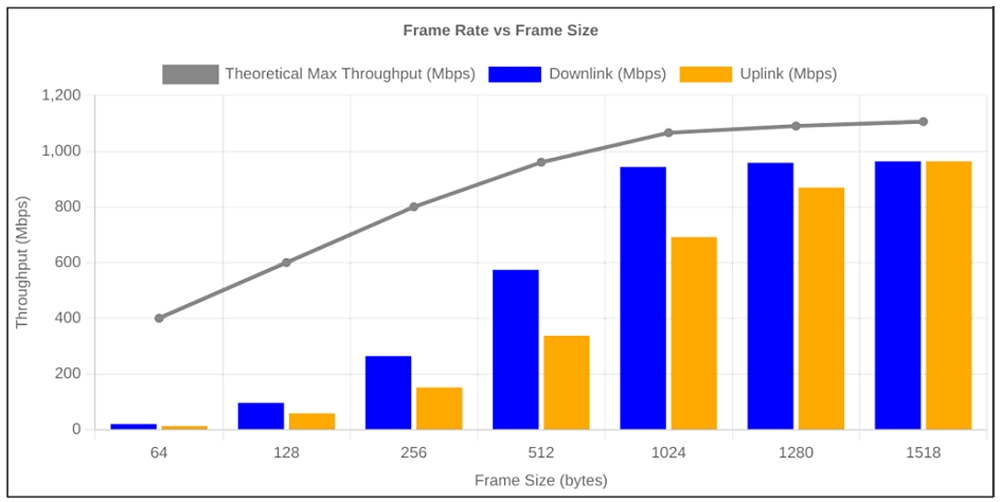
Example of RFC-2544 test to determine maximum throughput behavior of the device under test
As such, testing Wi-Fi 6/6E (and soon Wi-Fi 7) devices has become more complicated than traditional Wi-Fi device testing. Trying to test manually not only makes little economic sense, but it has become nearly impossible.
Automated testing of Wi-Fi devices
To overcome the complexity of testing a growing number of Wi-Fi 6/6E devices, automated device hardware and software testing is essential for cost-efficient, scalable, accurate, timely, and repeatable results.
Traditionally, test teams must research and keep up to date with evolving standards to create and execute tests. Alternatively, automated Wi-Fi automation packages from test experts like Spirent can be leveraged. Such automated test packages reflect existing standards and, where standards don’t yet exist such as for mesh networks, expertly define appropriate tests. Executing automated test software on your testbed enables fast, 24×7 testing. And all those resources that were grinding through test scenarios can instead put energies into evaluating results.
Spirent Wi-Fi automated test packages
Spirent, the Wi-Fi testing market leader, offers a wireless test bed that validates Wi-Fi networks and devices. Its software automation packages automate standards-based Wi-Fi test plans to assess conformance, interoperability, and performance.
To accelerate Wi-Fi testing, test automation packages spanning mesh interoperability performance testing of devices and device performance evaluation through RFC 2544 benchmark tests have been developed.
Learn more about how Spirent automated Wi-Fi test packages can enable you to quickly assess Wi-Fi device conformance to standards, interoperability, and performance.
Best effort. That about sums up expectations of Wi-Fi among daily users. In the coffee shop? Airport? The park? Our homes? We take what we can get. Some networks are better than others, but in the end, it’s always been “just Wi-Fi.”
The emergence of use cases for work-from-home, small business, hospitals, factories, and IoT, has elevated the importance of Wi-Fi, pushing it into the role of global wireless workhorse for our generation, and we expect, for the future. Yet, for all the performance demands being placed on Wi-Fi, it is tested infrequently and inconsistently. This stands in stark contrast to mobile networks, which are tested extensively by operators.
But this is changing. The rapid evolution of use cases, introduction of Wi-Fi 7, rivaling 5G tech and Wi-Fi’s anticipated convergence and harmonization with 5G represent a sea change. The latest tech advancements see Wi-Fi all grown up, with new responsibilities and expectations, and all the complexities of a mature, sophisticated technology. Especially for indoor environments, Wi-Fi 7 has the potential to rival what 5G can deliver, at a fraction of the cost.
Considering the COVID-19 impact on Wi-Fi in the wireless ecosystem – which didn’t change post-pandemic – service providers (SPs) needed to “up their game” to deliver the performance and QoS required to continue the productivity gains and economic trends established pre-pandemic. But offering bulletproof performance requires operators to adopt unprecedented, advanced testing and validation strategies.
In this new era of Wi-Fi, there’s no more room for error. Performance issues won’t just get a shoulder shrug. They’ll impact business revenues. Degrade user experiences. They’ll affect the bottom line. Meanwhile, competitive pressures will intensify at an accelerating velocity. Speed to market for a host of new devices with expanded feature sets will drive competitive battles. Just as importantly, it will necessitate a completely new approach to testing.
Competitive pressures will intensify at an accelerating velocity. Speed to market for a host of new devices with expanded feature sets will drive competitive battles. Just as importantly, it will necessitate a completely new approach to testing.
Goodbye disaggregation, hello results
In a previous post we discussed the rising urgency to streamline and automate Wi-Fi testing. Homegrown, multi-vendor testing shops based on garden-variety test products just weren’t meant for scale. Originally, within the more confined requirements of Wi-Fi’s earlier incarnation, they got the job done. But now, with Wi-Fi 7 offering customers 5G speeds and latency, based on a new set of standards, it’s a non-starter.
Today, Spirent recognizes a critical opportunity to evolve from slow and expensive DIY testing to turnkey, configurable Wi-Fi test suites that deliver a seamlessly integrated testbed. All without prohibitively large and expensive chambers typically employed for performance testing that comprised previous approaches.
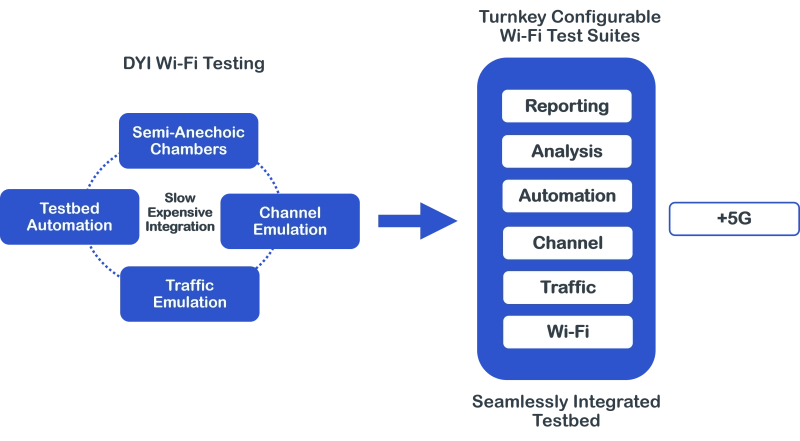
Evolution to a unified approach to Wi-Fi testing
It should be noted that a unified solution does more than just streamline processes – it impacts business outcomes.
Moving ahead, operators and device makers don’t want to buy test equipment – they want to buy results. And they need them as quickly as possible. Testing is emerging as not just a checkpoint before launch, but a driver of innovation itself. Wi-Fi 7 won’t be possible with a best-effort approach. It must be about maximizing performance results and getting them to market rapidly with advanced unified solutions.
Wi-Fi testing strategies for success
Spirent recognizes five key strategies for Wi-Fi 7 testing that merit serious consideration:
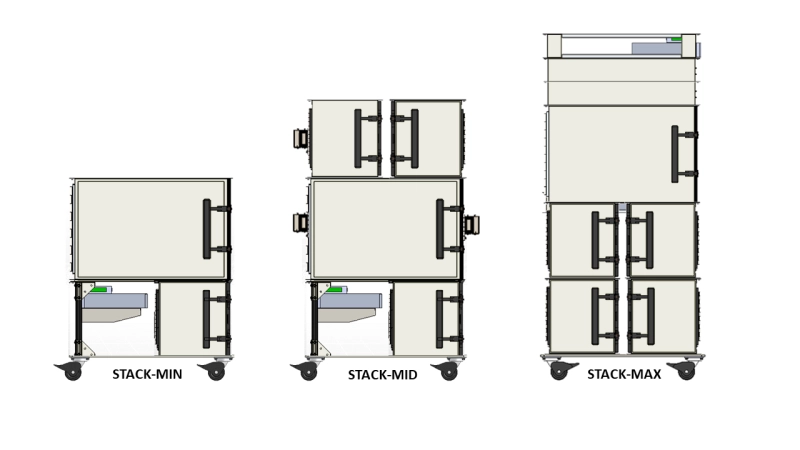
Wi-Fi’s role in work-from-home, along with new use cases for small business, hospitals, factories, IoT, and Wi-Fi 7’s promise, all represent a world of opportunity where this ubiquitous connectivity tech finally stands on its own as a highly capable, and highly performant solution for complex devices, services and access environments. But Wi-Fi’s full potential can only now be achieved with an evolved and holistic advanced test strategy that mirrors the ambitions of the technology itself.
Learn more about Spirent’s octoBox automated wireless testing solutions.
The latest generation of Wi-Fi, Wi-Fi 7, introduces a range of new capabilities for more sophisticated, higher-throughput/lower-latency wireless communications. Industry leaders anticipate that these features will enable a new generation of applications, from fully automated factories, to mass-scale Internet of Things (IoT) deployments, to immersive augmented reality (AR) gaming, and more. As with all technology advances, however, new Wi-Fi capabilities bring new technical complexity—and new challenges for those tasked with designing and debugging Wi-Fi devices.
Those seeking to exploit Wi-Fi 7 features such as multi-link operation (MLO), enhanced quality of service (QoS), and 4096 quadrature amplitude modulation (4K QAM) will find that legacy testbeds cannot provide the capabilities or visibility that such features require. Indeed, if testers can’t measure coordinated operations across radios, for example, or analyze next-generation modulation schemes, they can’t characterize how new features perform—much less debug devices when something goes wrong.
In our recent paper, Navigating Wi-Fi 7: A Deep Dive into Next-Gen Advancements, we provide an in-depth analysis of the revolutionary changes that Wi-Fi 7 introduces. We discuss the impact that these new features have on testing and the strategies Spirent is advancing to address them. This blog offers a brief overview of some of these innovations.
Measuring multi-link operation
Previous Wi-Fi generations enabled devices to use multiple radios simultaneously, either in the same or across multiple bands. Until now, though, each radio operated independently. Among its most powerful new capabilities, Wi-Fi 7 introduces coordinated multi-link operation (MLO) to improve throughput, increase reliability, or both.
Wi-Fi 7 adds a new Unified Upper MAC (UMAC) layer to coordinate multi-link operations in a multi-link device (MLD) architecture (Figure 1). The UMAC provides the higher-layer protocols with a single MAC address for data transfers in a way that is very familiar to current Wi-Fi radio users. Underneath this, the UMAC contains logic to distribute the data block across the individual radio links, as appropriate, and manage the flow of data at this lower link level. This lower-layer operation is invisible to the higher-layer protocols so that they do not need to care how many radios are being used, or in what way.
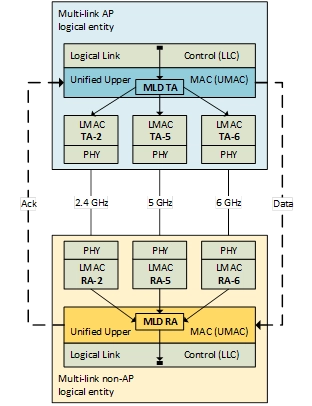


Figure 1. MLD architecture
With this additional layer of intelligence, the UMAC can distribute loads across multiple links to improve throughput and latency or transmit redundant packets to improve reliability (Figure 2).
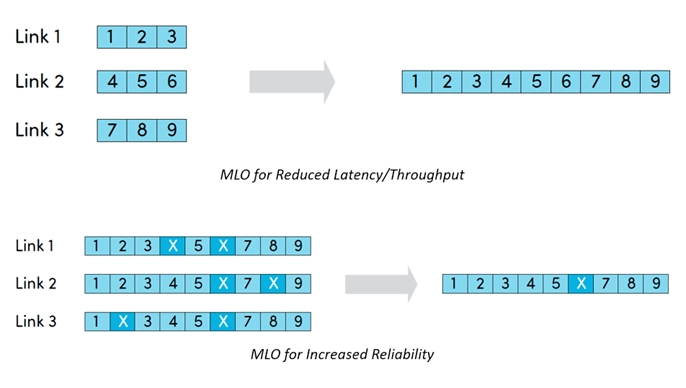

Figure 2. Overview of MLO in action
These MLO features can enable significant performance improvements for Wi-Fi users across a variety of scenarios. Validating them, however, requires new testing capabilities. To measure higher-throughput/lower-latency operations, for example, testbeds need additional computing resources to generate and consume traffic at higher rates. Testbeds must also provide visibility into the coordinated radio operations themselves. Effectively, all analysis and debugging capabilities previously performed on a per-radio basis must now extend to multiple radios operating simultaneously in concert.
Spirent’s new multi-link sniffer technology can analyze multiple bands simultaneously and provide consolidated operational data for use in Wireshark or other debugging tools.
Facilitating 4k QAM
As Wi-Fi has evolved over the years, modulation coding schemes (MCS) have evolved alongside it. Each new generation has supported more bits per symbol, increasing throughput by allowing devices to communicate more information per transmission.
However, denser QAM constellations also make devices more sensitive to channel noise—requiring ever-better signal-to-noise ratio (SNR). This issue has presented challenges through previous Wi-Fi evolutions, such as moving to 256 QAM (Wi-Fi 5) or 1024 QAM (Wi-Fi 6). As Figure 3 illustrates, however, the leap to 4096 QAM creates a constellation denser than anything Wi-Fi devices—and testbeds—have contended with before.
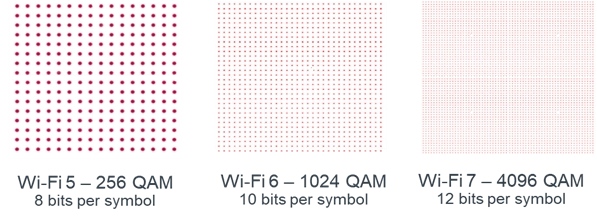

Figure 3. Increasing constellation density across Wi-Fi generations
At this density, channel noise that was acceptable in previous Wi-Fi generations can make it impossible to distinguish the position of individual points, introducing modulation errors. To capitalize on 4K QAM the new Wi-Fi 7 devices must be able to support these higher resolutions with finer decision boundaries, and testbeds must be redesigned to minimize as much path loss as possible.
Characterizing QoS enhancements
Latency also continues to improve with each new Wi-Fi generation, especially with the introduction of orthogonal frequency-division multiple access (OFDMA) in Wi-Fi 6, and deterministic latency in Wi-Fi 7. But to support more groundbreaking latency-sensitive applications QoS testing and reporting must also evolve. As part of the Device Metrics Test Plan for Wi-Fi 7, the Wi-Fi Alliance highlighted the need for latency testing that provides not just average one-way delay (OWD), but a detailed statistical spread.
This level of insight is essential for characterizing performance in scenarios where multiple users are contending for the same channel resources, causing latency to fluctuate. For example, consider an AR gaming application where latency exceeding 30 milliseconds will be noticeable (and disruptive) to users. Legacy testing might show that, with OFDMA enabled, a device maintains 30ms average OWD. But knowing that average isn’t particularly helpful if the latency periodically spikes to 100ms, ruining user sessions.
To guarantee consistently good experiences, device makers must know the full range of latency users can experience, how various mechanisms affect delay, and how often OWD exceeds maximum thresholds. Spirent’s OCTOBOX testbeds report not just the average latency but the full statistical distribution. For example, Figure 4 illustrates the change is OWD distribution gained by using OFDMA. This allows testers to fully characterize performance and determine a statistical measure of the probability of achieving any target delay—critical information for guaranteeing QoS in emerging applications.
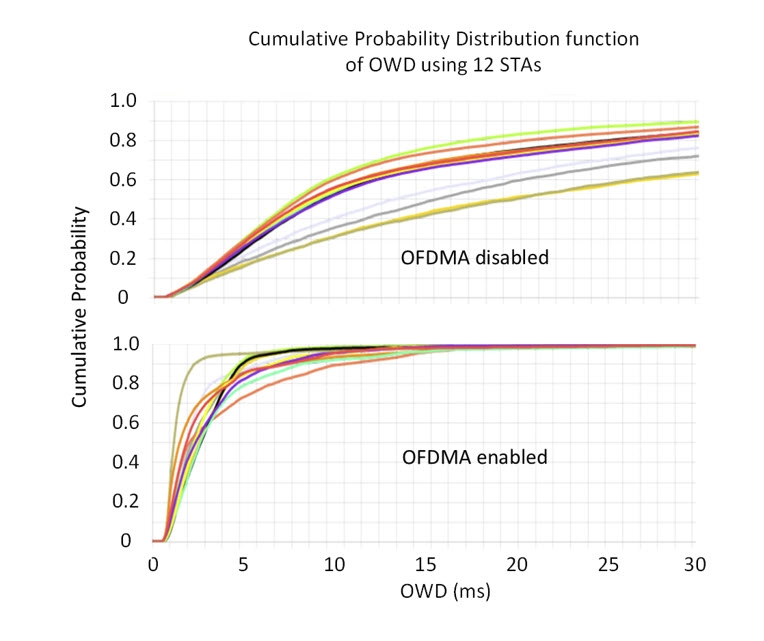

Figure 4. Characterizing device performance with and without OFDMA
The Spirent advantage
As a global leader in wireless testing solutions, Spirent has a long history of continually expanding the in-depth statistics and performance indicators our OCTOBOX testbeds provide to help organizations capitalize on new technologies. In fact, Spirent is typically the first in the industry in enabling in-depth testing and validation for new Wi-Fi advances. Why are we so often ahead of the curve? Because we’re intimately involved in the groups developing and standardizing wireless innovations.
Spirent is extremely active working across the industry to understand the implications of new wireless standards for our customers and what’s needed to test and characterize their performance. That includes working directly with leading wireless equipment and device manufacturers but also participating in industry groups like the Wi-Fi Alliance and IEEE. Spirent engineers currently serve on multiple Wi-Fi Alliance task groups, including leading the group that developed the Wi-Fi 7 Device Metrics Test Plan.
As a result, we don’t have to wait until new standards are finalized to know what will be needed to test them. So, when groundbreaking Wi-Fi advances emerge, we can help our customers start using and benefiting from them right away.
For more details on cutting-edge Wi-Fi 7 features and the latest approaches to characterize their performance, download the new whitepaper Navigating Wi-Fi 7: A Deep Dive into Next-Gen Advancements.

Wi-Fi conformance and performance testing for devices is critical whether it’s for Wi-Fi 6/6E or 7, which is on the horizon. As a result, there are new test plan approaches being developed for the new challenges that are being introduced as these technologies advance.
Wi-Fi Alliance members, including Spirent, have collaborated to produce a Wi-Fi performance test plan describing a relatively simple testbed that provides all the means necessary to perform a wide variety of Wi-Fi tests. The testbed provides a foundation to ensure repeatable and reproduceable RF testing and will likely be the cornerstone of further revisions, enhancements, and expansion of the test plan.
While small chamber over-the-air (OTA) testing is becoming the de facto method for testing, the Wi-Fi Device Metrics Test Plan introduces approaches that we believe are unique from other test plans in the industry.
The testing methodology limits the number of test parameters and avoids needless nested parameter loops by specifying fixed “external” parameters like topology, number of devices etc., and allows the tester to save time and money by focusing on “internal” parameters like security, NSS, and others, as appropriate for their organization. Since more and more consumer devices are pre-, or self-configuring, Wi-Fi Device Metrics encourages out-of-box testing to emulate a customer’s experience.
Real-world customer environments produce results with wide variation. Wi-Fi Device Metrics recognizes this and recommends presentation of results in a statistical manner, rather than just a single number. Each test produces a wealth of data and Wi-Fi Device Metrics details ways that this test data can be efficiently analyzed to provide statistical analysis that more accurately illustrates the customer’s experience.
In the beginning
In the early days of Wi-Fi, RF performance was characterized in the lab using RF cabled setups usually housed in shielded RF rooms. Testing tended to be very specifically PHY related, concentrating on TX power, RX sensitivity, spectral mask, EVM and so on. MAC/PHY testing was covered by Wi-Fi Alliance interoperability testing but testing of radio performance in the real world was limited.
OTA RF performance testing is complicated. Often, it was performed in shielded RF rooms, but generally the results were unreliable because standing waves and movement of people within the chamber caused signal variations as much as 70 dB. Open air testing was often performed in a dedicated test home, which gave some degree of real-world assessment, but again reflections and interference almost guaranteed Never The Same Result Twice (NTSRT).
Nearly all of these legacy test methodologies were aimed at point-to-point connections, which is in line with the goals of all Wi-Fi generations up to Wi-Fi 5.
Wi-Fi 6 was designed to give better user performance to a community of concurrent users in the presence of overlapping basic service set (OBSS) interference. This broke the legacy mold for testing.
State of the art testing today
The testbed
Now, a testbed needs to contain multiple devices, up to 37 in the case of OFDMA. The testbed must reproduce spatial diversity for MU-MIMO to be tested, there must be facility to generate OBSS traffic, and there is a need for multiple sniffer devices. Cabling such a setup is impractical and all the same NTSRT problems still remain in an OTA environment.
The Device Metrics testbed is built using relatively small anechoic chambers and uses directional antennas to “couple” RF energy into, and out of, the chamber. This approach limits the signal variability due to standing waves, avoids the need to disassemble the device to make a physical connection, and provides good spatial diversity to support MU-MIMO operation, as explained further in Small Anechoic Chamber Channels and Near Field MIMO Channel Modeling with applications to Small Anechoic Chambers. The chambers are interconnected with RF cables through variable attenuators to simulate distance.
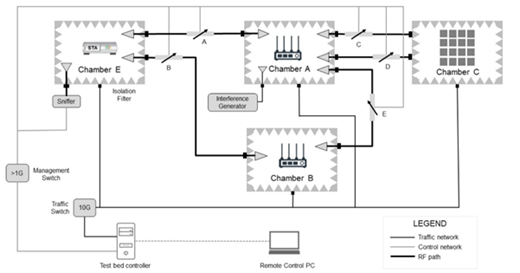
This type of testbed is relatively new in the industry and has been shown to give results that are repeatable (on the same system), and reproduceable (on a remote system). It is rapidly becoming accepted as the de-facto way to test Wi-Fi as evidenced by other standards bodies such as Broadband Forum, ETSI, and others.
Along with the testbed, the test measurement methodology also needs to change. Methodologies like RFC 2544, which rely on the system to be in equilibrium for a measurement to be performed, are no longer useful because of the continuous variation of the measured parameters caused by all the other devices also contending for the channel.
Better performance indicators
Performance indicators of interest need to be more sophisticated. The traditional raw throughput with one device is less useful in the context of real-world testing where we need to assess the combined experience of a community of users. Instead, we see aggregated throughput, individual device latency, and roaming performance becoming more important.
Wi-Fi Device Metrics use modern traffic generation tools such as multiPerf that provide second-by-second key performance indicator data so that the variability of results can be captured and analyzed. MultiPerf also provides more sophisticated analysis capabilities, for example, measuring the packet-by-packet distribution of one-way delay (OWD).
MultiPerf also has more sophisticated traffic generation modes that help the tester more accurately mimic real-life applications. For example, multiPerf allows one to generate traffic with a specified data rate mean and variance to mimic a user. Indeed, it goes further to produce isochronous traffic at a specified frame rate to mimic voice or video.
Comprehensive presentation of results
As mentioned earlier, the presentation of the metrics needs to be revised. A single throughput number, or a single delay number is not that useful because, in practice there is always a distribution of results, and it is often the spread of those results that affect users more adversely.
Wi-Fi Device Metrics recognizes this fact and proposes a much more statistical analysis of the results, which are presented in various levels of detail.
The first level will typically be in tabular form presenting the mean, standard deviation, coefficient of variance, and performance at certain percentiles. This is useful for simple reports, perhaps for regression testing, where the numbers can be compared, or matched up with the testers’ own criteria for pass/fail.
The next level will be to generate Probability Distribution Functions (PDF) and Cumulative Distribution Functions (CDF) to visualize the spread of results so that anomalies can be illustrated. Depending upon the test case, other detailed analysis and visualization is performed, as appropriate.
An example of packet delay results
An example of this analysis is shown in the image below where the latency test produces a PDF of packet delays on a packet-by-packet basis. Here we mimic multimedia by generating isochronous, variable bit rate traffic.
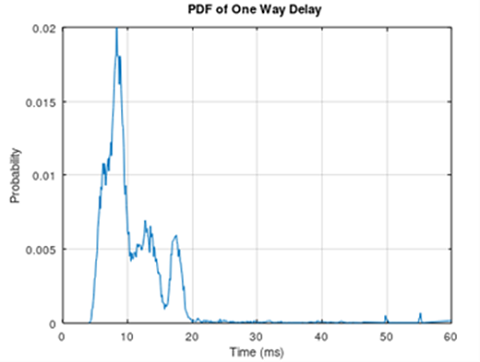
Generally, real time video or voice is fairly tolerant to a reasonable mean delay, but the tails of the delay spread are the parts that irritate the customer.
Explicit examination of the spread is important to gauge customer experience. This graph shows a mean delay of about 8 ms. Delays around 20 ms are unlikely to cause problems, but there is a finite probability of delays at 50 ms, 55 ms, and beyond, which might disrupt a voice or video stream occasionally and would be irritating to the user.
Spirent Wi-Fi testing
As a leader in Wi-Fi performance testing for devices and access points, Spirent is a key member of the Wi-Fi Alliance task group and regularly contributes to their evolving standards. In doing so, we continually gain insights for developing our automated testbeds to meet the demand for the ever-changing Wi-Fi technology industry.

Each generation of Wi-Fi has delivered higher data rates with a focus on improving performance for end users. It’s an increasingly tall order—consider the average family surrounded by devices all contending for the same airwaves. Or the same scenario faced by an enterprise user.
Wi-Fi 6 aimed to solve this dynamic in home and at the office. It was a paradigm shift that introduced new functionality and mechanisms to better support multiple users. Close on Wi-Fi 6’s heels came Wi-Fi 6E, which incorporated use of the 6 GHz spectrum.
Anticipating what’s next, the industry has its sights set on Wi-Fi 7, which promises to refine and expand Wi-Fi 6 functionality in the 6 GHz spectrum. It adds new features and mechanisms aimed at finally tackling issues that have persistently snarled certain Wi-Fi use cases.
While higher throughput—up to 12 Gbps—is the main benefit of Wi-Fi 7, it is not achieved easily.
Let’s explore why, and implications, starting with a look at Wi-Fi 7’s core capabilities and benefits.
320 MHz bandwidth for much more data
Similar to Wi-Fi 6E, Wi-Fi 7 uses the 6 GHz spectrum that can support channels as wide as 320 MHz—twice what is supported by Wi-Fi 6E and four times Wi-Fi 6. In fact, with Wi-Fi 7, you can get three 320 MHz channels in the 6 GHz band. Because a wider channel can transmit more data, Wi-Fi 7’s pipe is larger than ever.
But is that spectrum actually usable? Such a wide 320 MHz channel is likely to have an interferer in the band which means sections of the channel might be unusable. Wi-Fi 7 deals with this by using a mechanism to puncture out that part of the spectrum so that it is partitioned, but the rest of the 320 MHz channel can be used.
Elevated order modulation for 20% higher speed
Quadrature amplitude modulation (QAM) conveys data over radio waves using discrete points in the constellation diagram. Each discrete point represents a number of bits of data. The more allowable discrete points, the more data that can be transmitted. Wi-Fi 6 provides 1024 (point) QAM, a 25% increase data rate from Wi-Fi 5. Wi-Fi 7 has increased it another 20% to 4096 QAM, which is 12 data bits per symbol.
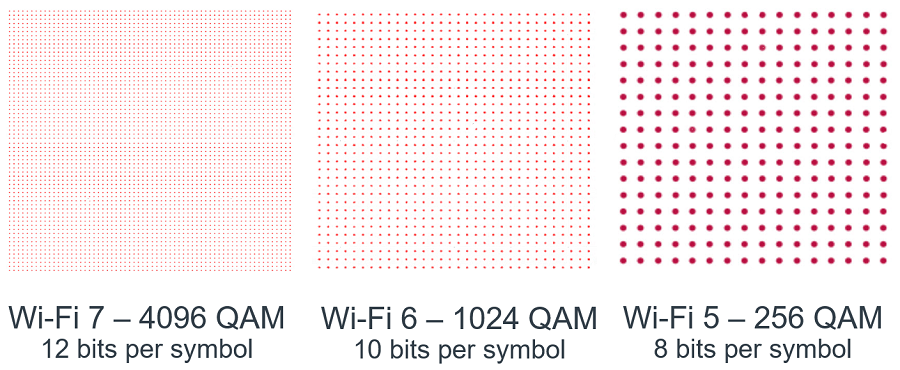
The problem with this high order modulation is the impact of channel noise, which makes demodulation difficult. Although 4096 QAM is fast, it needs a high signal-to-noise ratio (SNR) to work properly. That limits its use to short operating distances of about 18 feet—inferior for some applications, but excellent for others, such as virtual reality.
Multiple Resource Units provide better spectrum efficiency
OFDMA improves performance by allowing simultaneous transmissions between multiple clients. With Wi-Fi 6 and LTE, a channel can be divided into Resource Units (RUs), which are frequency groupings. Each device is allocated one RU. To provide better spectrum efficiency, Wi-Fi 7 allows multiple RUs to be allocated to each device, making use of otherwise potentially unused spectrum.
Multi-link operation increases link and channel efficiency
In traditional Wi-Fi mesh networks, each mesh node communicates with the devices close to it on a single band and the mesh nodes communicate with each other. This is sometimes not an efficient approach for device-to-device traffic. Instead, with Wi-Fi 7, multi-link operation (MLO) enables multiple simultaneous links to operate in separate channels, with each link operating independently. For example, 2.4 GHz, 5 GHz and 6GHz radios can all be used as though they were one.
MLO is an important new feature in Wi-Fi 7. It is a unified and consistent framework to consistently manage multiple links, reducing management overhead. By aggregating links on different channels, MLO increases throughput. It also improves latency by using multiple links in parallel for flexible channel access. Reliability can be increased by sending duplicated data on multiple links, and quality of service (QoS) can be improved by assigning traffic to appropriate links.
Enhanced QoS management for priority access
Normally, all devices contend for a single channel on a first come first served basis. This is a non-starter for applications like voice calls, where timing is critical.
Wi-Fi 7 introduced enhanced QoS Management so that devices can request guaranteed time. For example, they would inform the access point that a voice call will need 5 ms every 20 ms. The access point will then pre-allocate the channel if possible. This guarantees access to the channel when the voice packet is transmitted. Enhanced QoS management provides smoother channel access management than previous first come, first served methods.
Restricted service periods for deterministic latency
Latency is important for enhanced reality. Wi-Fi 6 improved latency with OFDMA but, depending on the number of gamers in the house, the latency could fluctuate significantly. Wi-Fi 7 can provide deterministic latency that reserves what you need when you need it.
Wi-Fi 7 testing considerations
Wi-Fi 6’s new features had major testing implications which need to be further refined for Wi-Fi 7. The biggest impact is multi-link operation, which will need new testing methodology and test plans for its more consistent, but a different approach compared to standard mesh device testing. Similarly, testing methodologies need to be enhanced for targeted QoS wait time.
As always, test planning will leverage Wi-Fi Alliance test plans when they become available. In the meanwhile, maintaining an up-to-date testing approach for Wi-Fi 6 and Wi-Fi 6E is essential to keep pace with evolving Wi-Fi technology.
Learn about Spirent’s Test as a Service for Wi-Fi devices and read the eBook Testing Wi-Fi for High-Performance Use Cases.
Unique TaaS option enables Wi-Fi manufacturers to access the most sophisticated test procedures on an as-required basis
Available to customers globally, the service is based at Spirent’s Massachusetts research facility where OCTOBOX testbeds are developed and manufactured. This allows Spirent to easily scale up and down testing services for customers based on their ever-changing needs and leverage the company’s unrivalled Wi-Fi emulation and testing expertise. The Spirent lab also provides test environments that are engineered with optimized hardware to ensure all devices are validated against the highest quality standards accepted for deployment by carriers and enterprises, such as TR-398 and RFC 2544.
“While many test facilities use software-based testbeds, these are unable to perform realistic test scenarios that model actual deployments,” said Roberts. “They often lack the ability to produce deterministic results which is essential for repeatability. By utilizing our OCTOBOX testbeds along with our automation framework, we emulate real world scenarios such as congestion, interference, distance, and movement – all of which affect the quality of the user experience.”
For more information about Spirent’s Test as a Service for Wi-Fi Devices, visit www.spirent.com/products/wi-fi-testing-services.
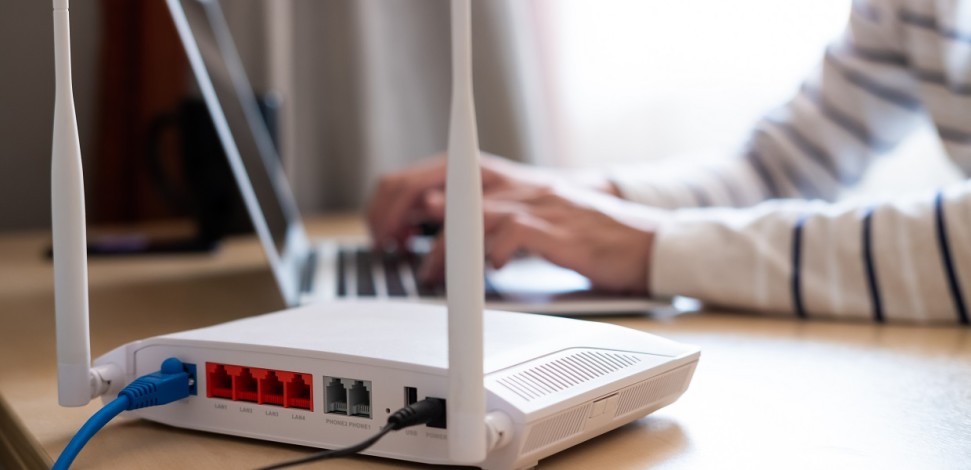
Going on two decades, Wi-Fi has delivered simple, inexpensive wireless connectivity for the masses. It was never perfect, but the convenience and generally fine performance for most applications made it good enough for most.
Now, the stakes are higher.
Consumers are requiring more demanding use cases and more powerful apps. Despite its promises, 5G connectivity remains limited. This has meant everyone from personal to enterprise users have been leaning heavier than ever on Wi-Fi to meet connectivity needs.
This has been a driving force behind a whole new generation of Wi-Fi tech and adoption. Whether working or playing from home, we expect Wi-Fi to operate flawlessly with high performance and reliability. This is especially true as Wi-Fi cements a role in mission-critical private networks that support emerging industry applications.
Wi-Fi 6 and 6E are being positioned to meet these new roles and requirements. The new Wi-Fi standards provide distributed connectivity, high throughput, and low latency. In particular, the radio interface has received an overhaul, with modulation and spectral efficiency on a completely new level.
Wi-Fi 6 routers, extenders, and mesh networks are being installed in homes and offices to provide wider coverage, support more users, and accommodate a growing range of devices. Each brings pros and cons, but whichever is chosen, it is safe to say Wi-Fi networks have evolved far beyond initial roles as simple routers.
In fact, the changes seen in Wi-Fi 6/6E introduce challenges that are in some ways more significant than the migration from 4G to 5G.
New Wi-Fi complexity means device testing has grown in complexity, too
As expectations of Wi-Fi surge, so too does the need for precise, comprehensive Wi-Fi network testing. As always, testing must address conformance to standards, interoperability, and performance. With Wi-Fi, many factors can impact performance, such as walls, electrical interference, , signal reflection, and other Wi-Fi and wireless usage in the area. All Wi-Fi 6/6E devices must be tested against these factors in controlled, repeatable ways.
Wi-Fi 6/6E sees multiple standards in play, including TR-398 performance for routers and access points, RFC-2544 network device benchmarking specification, and others in the offing. Still, as this next generation of Wi-Fi comes to market quickly, comprehensive test and interoperability standards have yet to be developed.

Example of RFC-2544 test to determine maximum throughput behavior of the device under test
As such, testing Wi-Fi 6/6E devices has become more complicated than traditional Wi-Fi device testing. Trying to test manually not only makes little economic sense, but it has become nearly impossible.
Automated testing of Wi-Fi 6/6E devices
To overcome the complexity of testing a growing number of Wi-Fi 6/6E devices, automated device hardware and software testing is essential for cost-efficient, scalable, accurate, timely, and repeatable results.
Traditionally, test teams must research and keep up to date with evolving standards to create and execute tests. Alternatively, automated Wi-Fi automation packages from test experts like Spirent can be leveraged. Such automated test packages reflect existing standards and, where standards don’t yet exist such as for mesh networks, expertly define appropriate tests. Executing automated test software on your testbed enables fast, 24×7 testing. And all those resources that were grinding through test scenarios can instead put energies into evaluating results.
Spirent Wi-Fi 6/6E automated test packages
Spirent, the Wi-Fi testing market leader, offers a wireless test bed that validates Wi-Fi networks and devices. Its software automation packages automate standards-based Wi-Fi test plans to assess conformance, interoperability, and performance.
To accelerate Wi-Fi 6/6E testing, test automation packages spanning mesh interoperability performance testing of devices and device performance evaluation through RFC 2544 benchmark tests have been developed.
Learn more about how Spirent automated Wi-Fi test packages can enable you to quickly assess Wi-Fi device conformance to standards, interoperability, and performance.
The advancement of technology has done great things for society. Today, innovations from autonomous vehicles to advanced pacemakers rely on more than microprocessors and software but the underlying network that seamlessly connects everything together. Yet issues with connectivity – from poor latency to instability under certain scenarios – can have a massive impact on the viability of many critical use cases. For both device manufacturers and service providers, network assurance testing is of paramount importance – but it’s a task that is becoming increasingly complex due to the highly varied array of network types and usage scenarios that must be validated.
This need to simplify and improve these assurance processes is one of the reasons why Spirent and octoScope became a single company last March. Everybody in the industry knows that OCTOBOX is a leading testbed for automated validation of Wi-Fi networks and devices. Even when we were rivals, from an engineer’s standpoint, we could not help admiring the compact yet stackable approach that made it easy to create a robust testbed suited to a wide variety of scenarios.
However, as Spirent, before we joined forces, we still had many joint customers that needed to perform more specialist assurance scenarios that were not well suited to OCTOBOX. Especially for granular channel emulation or for use cases where complex mobility was involved. For these customers, it meant potentially setting up dual test beds running Spirent and OCTOBOX products for very different workloads. This also required integrating these disparate solutions and then trying to tie the data together into a coherent set of results. Not an impossible task but far from ideal.
Two heads…
In a world getting more complex, this highlights one of the fundamental benefits of our union – the ability to create new products that combine our expertise and technologies into a better overall solution. A coherent approach that is not only easier to use but also more suited to the diversity of use cases that we are all seeing across our modern society. It has been nearly a year of intense engineering work, but the first fruits of that vision have ripened. We are proud to announce the launch of an integrated solution that combines the modular nature of OCTOBOX with Vertex, our channel emulator able to replicate the comprehensive noise and spatial conditions of even the most complex wireless channels.
In simple terms, we now have a solution that combines best in class traffic emulation, channel emulation and performance evaluation into an integrated platform. And this arrives at a time where we are seeing an explosion in new devices like wearables and industrial IoT along with a major shift due to the emergence of 5G that will spawn new use cases that will really push legacy testing methodologies. No matter the vertical market, we are all being forced to answer new questions: How will this device work on an airplane’s Wi-Fi network from take-off to landing? What happens if a medical device loses connection as it’s being moved between hospital wards? What impact will load have on network latency for a particular sensor used on a busy factory production line? Can an autonomous vehicle seamlessly move between 5G and Wi-Fi based control without incident? We could ask pages and pages of questions like these that need to be answered before innovation can go from the drawing board to real world application!
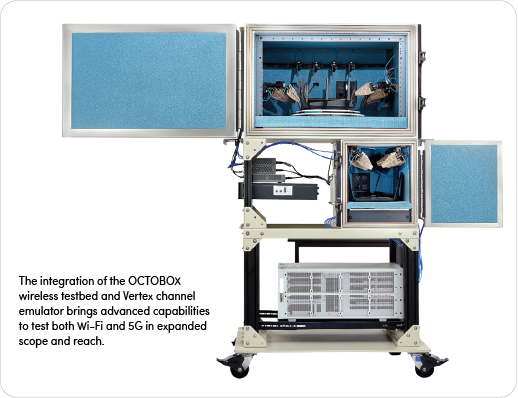
Keep it simple
There are literally hundreds of scenarios where the answers will not just impact physical product design, but also have a ripple effect on device placement and day-to-day operating procedures. Making it easier to simulate these scenarios, gain answers and then adapt to change is fundamentally important for everybody concerned with test and assurance.
Even with our integrated OCTOBOX / Vertex solution now heading out into the field for real world use, this ongoing strategy to overcome complexity will continue. Other ways in which we can integrate the best of octoScope and third-party technologies into better solutions continues within our R&D teams. It must, because we know that the world will always find new ways to blend technology and connectivity to create amazing ideas. Hopefully, we can equip the people who make sure these things work in the real world with the right tools to get this vital job done efficiently and accurately with simple-to-use platforms.

As the demand for 5G and Wi-Fi 6 continues to grow at a rapid pace and their standards become increasingly entwined, there has never been a better time to look at the possibility of convergence between the two technologies.

There are more than 16 billion wireless devices in the world today, driving $3.3 trillion in global economic value. The industry will ship an additional 4 billion Wi-Fi devices in 2021 alone.
This incredible growth is driven not only by existing use cases, but also emerging ones. From shopping malls and office buildings to factories and hospitals, reliance on Wi-Fi is pervasive and there’s a heightened priority to rigorously test Wi-Fi products before they ship.
Tech thought leader Diana Adams recently joined me to talk about key insights from Spirent’s new eBook, Testing Wi-Fi for High-Performance Use Cases. Watch the video below as we discuss how Wi-Fi testing today is critical for tomorrow’s wireless world.
Wi-Fi Testing Today Is Critical for Tomorrow’s Wireless World – Spirent
To learn more about Wi-Fi testing, download the eBook.